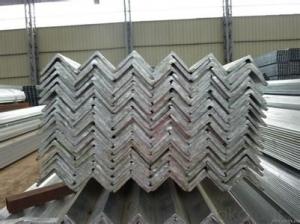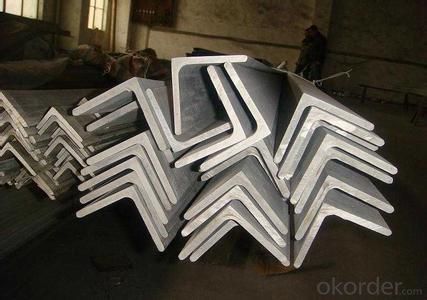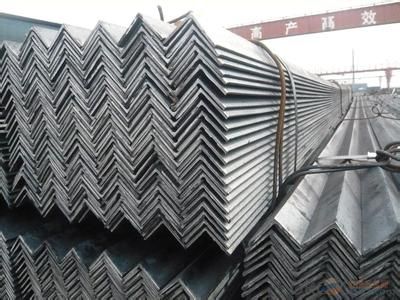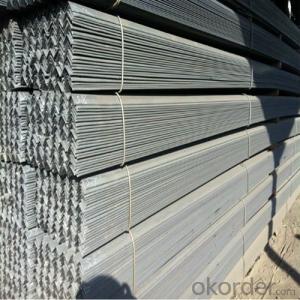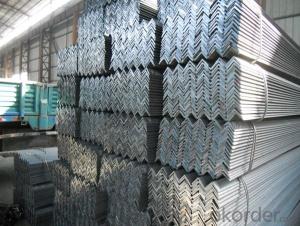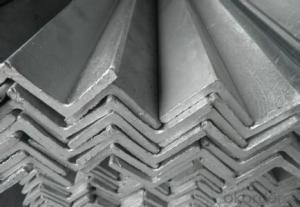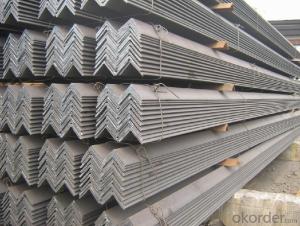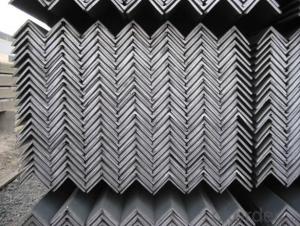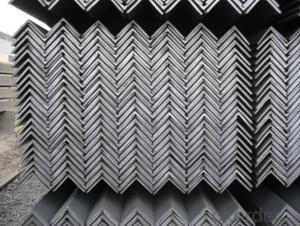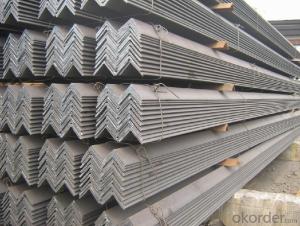Angle Steel Hot Rolled High Quality ASTM A36 25-250MM
- Loading Port:
- Tianjin
- Payment Terms:
- TT OR LC
- Min Order Qty:
- 25 m.t.
- Supply Capability:
- 20000000 m.t./month
OKorder Service Pledge
OKorder Financial Service
You Might Also Like
Specification
Product Description:
OKorder is offering Angle Steel Hot Rolled High Quality ASTM A36 25-250MM at great prices with worldwide shipping. Our supplier is a world-class manufacturer of steel, with our products utilized the world over.
Product Applications:
According to the needs of different structures, Angle can compose to different force support component, bridges, transmission towers, hoisting machinery and transport machinery, ships, industrial furnaces, reaction tower, container frame and warehouse etc
Product Advantages:
OKorder's Angle Steel Hot Rolled High Quality ASTM A36 25-250MM are durable, strong, and resist corrosion.
Main Product Features:
· Premium quality
· Prompt delivery & seaworthy packing (30 days after receiving deposit)
· Corrosion resistance
· Can be recycled and reused
· Mill test certification
· Professional Service
· Competitive pricing
Product Specifications:
Manufacture: Hot rolled
Grade: Q195 – 235
Certificates: ISO, SGS, BV, CIQ
Length: 6m – 12m, as per customer request
Packaging: Export packing, nude packing, bundled
Sizes: 25mm-250mm | ||||||||||||
a*t | ||||||||||||
25*2.5-4.0 | 70*6.0-9.0 | 130*9.0-15 | ||||||||||
30*2.5-6.6 | 75*6.0-9.0 | 140*10-14 | ||||||||||
36*3.0-5.0 | 80*5.0-10 | 150*10-20 | ||||||||||
38*2.3-6.0 | 90*7.0-10 | 160*10-16 | ||||||||||
40*3.0-5.0 | 100*6.0-12 | 175*12-15 | ||||||||||
45*4.0-6.0 | 110*8.0-10 | 180*12-18 | ||||||||||
50*4.0-6.0 | 120*6.0-15 | 200*14-25 | ||||||||||
60*4.0-8.0 | 125*8.0-14 | 250*25 | ||||||||||
FAQ:
Q1: Why buy Materials & Equipment from OKorder.com?
A1: All products offered byOKorder.com are carefully selected from China's most reliable manufacturing enterprises. Through its ISO certifications, OKorder.com adheres to the highest standards and a commitment to supply chain safety and customer satisfaction.
Q2: How do we guarantee the quality of our products?
A2: We have established an advanced quality management system which conducts strict quality tests at every step, from raw materials to the final product. At the same time, we provide extensive follow-up service assurances as required.
Q3: How soon can we receive the product after purchase?
A3: Within three days of placing an order, we will begin production. The specific shipping date is dependent upon international and government factors, but is typically 7 to 10 workdays.

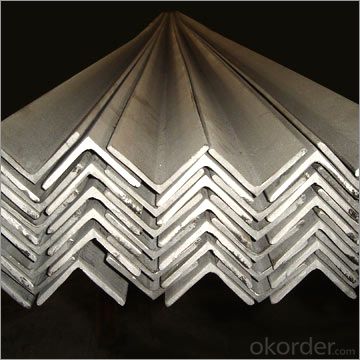
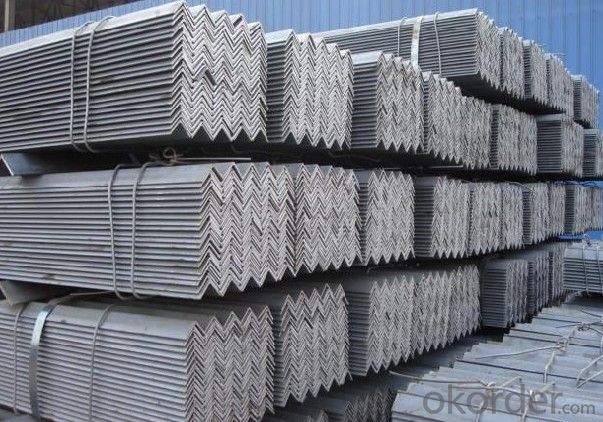
- Q: Are steel angles affected by vibration?
- Vibration can indeed impact steel angles. When exposed to consistent or repetitive vibrations, steel angles may experience fatigue or stress cracking over time. This occurs because vibrations, particularly those with high frequency or amplitude, can induce dynamic loads on the steel angles. These loads can result in cyclic stresses and strains, ultimately causing damage to the material. In certain instances, excessive vibrations can even lead the steel angles to resonate, resulting in amplified oscillations that can lead to structural failure. It is important to acknowledge that the vulnerability of steel angles to vibrations is influenced by various factors, including the steel's quality and strength, the magnitude and frequency of vibrations, and the structure's design and installation. To mitigate the effects of vibration on steel angles, engineers and designers often utilize diverse techniques. These may include implementing damping systems, employing vibration isolation methods, or reinforcing the structure to enhance its resistance to dynamic loads. Regular inspections and maintenance are also vital to detect and address any potential issues caused by vibrations. By doing so, the structural integrity and durability of steel angles can be ensured.
- Q: Can steel angles be used in the construction of shopping malls?
- Yes, steel angles can be used in the construction of shopping malls. Steel angles are versatile structural components that can provide support and stability to various elements of a building, including shopping malls. They are commonly used in the construction industry for framing, bracing, and reinforcing structures. Steel angles can be used to support the walls, roof, and floors of shopping malls, ensuring the structural integrity of the building. Additionally, they can be used in the construction of staircases, escalators, and mezzanines within the shopping mall. The use of steel angles in shopping mall construction offers several advantages, including their durability, strength, and cost-effectiveness.
- Q: What are the different types of steel angles used in automotive manufacturing?
- There are several types of steel angles used in automotive manufacturing, including equal angles, unequal angles, and L-shaped angles. These angles are commonly used in various structural components of vehicles, such as chassis frames, suspension systems, and body reinforcements.
- Q: Can steel angles be used for staircase handrails?
- Yes, steel angles can be used for staircase handrails. Steel angles are versatile and strong, making them a suitable choice for supporting and providing stability to staircase handrails. They can be easily welded or bolted to the staircase structure, ensuring a secure connection. Steel angles are also available in various sizes and lengths, allowing for customization to fit the specific dimensions and design requirements of the staircase. Additionally, steel angles can be finished with different coatings, such as powder coating or galvanization, to enhance their durability and resistance to corrosion. Overall, steel angles offer a practical and reliable option for constructing staircase handrails.
- Q: What are the different methods for reinforcing steel angles?
- There are several methods for reinforcing steel angles, including welding additional steel plates or bars to the angle to increase its strength and stability, using brackets or gussets to provide additional support, and using adhesive bonding agents or epoxy coatings to enhance the bond between the angle and the surrounding structure. These methods help to ensure that the steel angle can withstand higher loads and provide better resistance against bending or twisting forces.
- Q: How do you reinforce a steel angle for added strength?
- To reinforce a steel angle for added strength, there are several techniques you can employ. One common method is to weld additional steel plates or gussets to the angle's flanges. These plates or gussets are typically positioned perpendicular to the angle and are welded along their edges to create a stronger connection. This helps distribute the load and enhance the structural integrity of the angle. Another approach is to bolt or rivet additional steel plates or angles to the existing one, creating a sandwich-like structure. These additional plates or angles can be positioned on either side of the existing angle or even on top, depending on the specific requirements. Bolting or riveting them together ensures a secure connection and reinforces the angle's overall strength. Furthermore, reinforcing a steel angle can also be achieved by employing bracing techniques. This involves adding diagonal steel members, often referred to as braces, to the angle. Braces are typically attached to the angle at multiple points using welding or bolting methods. These braces help redistribute the forces acting on the angle and prevent excessive deflection or bending, thereby increasing its strength. It is important to note that the specific reinforcement method chosen depends on factors such as the load or force the angle will experience, the desired level of strength, and the available resources. Consulting with a structural engineer or a professional in the field is highly recommended to ensure the appropriate reinforcement technique is selected and implemented correctly.
- Q: How do you calculate the section modulus of a steel angle?
- The section modulus of a steel angle can be calculated by dividing the moment of inertia of the angle cross-section by the distance of the furthest point from the centroid to the extreme fiber.
- Q: What are the different manufacturing processes for steel angles?
- Steel angles can be manufactured using various methods, each with its own advantages and applications. 1. The most common method is hot rolling. It involves heating a large billet of steel and passing it through rollers to shape it into the desired angle. This process provides precise control over dimensions and shape, resulting in high-quality products. 2. Cold drawing is another process where a steel billet is pulled through a die to form the angle shape. It is commonly used for smaller and intricate angles, offering greater control over dimensions and surface finish. It also improves mechanical properties like strength and hardness. 3. Extrusion is a method where a heated billet of steel is forced through a die using high pressure. It is suitable for producing complex and custom-designed angles with unique cross-sectional profiles. 4. Bending involves using specialized machinery to bend a flat piece of steel into the desired angle shape. It is often used for smaller angles with specific dimensions or custom requirements. 5. Welding is another method where two or more steel plates or sections are welded together to form the angle. It is commonly used for producing large and heavy-duty angles that require additional strength and stability. Each of these manufacturing processes offers unique benefits and is suitable for specific applications. The choice of process depends on factors such as desired dimensions, tolerances, surface finish, mechanical properties, and production volume.
- Q: What are the maintenance requirements for steel angles?
- The maintenance requirements for steel angles can vary depending on the specific environment and conditions they are exposed to. However, there are some general guidelines to follow to ensure their longevity and functionality. Firstly, it is important to regularly inspect steel angles for any signs of damage or corrosion. This can be done by visually examining the angles and checking for any discoloration, rust, or surface irregularities. If any issues are detected, they should be addressed promptly to prevent further deterioration. Cleaning the steel angles on a regular basis is also essential. This can be done by using a mild detergent or soap solution and a soft cloth or sponge. Avoid using abrasive cleaners or tools that can scratch the surface of the angles. After cleaning, it is important to thoroughly rinse the angles with clean water and dry them completely to prevent moisture buildup. To protect steel angles from corrosion, applying a protective coating or paint is recommended. This can act as a barrier against moisture and other corrosive elements. It is important to choose a coating or paint that is specifically designed for steel and suitable for the intended environment. Regular inspection and touch-up of the coating or paint may be necessary to maintain its effectiveness. Additionally, it is crucial to prevent prolonged exposure to harsh chemicals or corrosive substances that can damage the steel angles. If the angles are installed in an environment where they may come into contact with such substances, it is important to provide appropriate protective measures, such as using chemical-resistant coatings or barriers. Finally, it is advisable to follow any specific maintenance recommendations provided by the manufacturer or supplier of the steel angles. They may have additional guidelines or requirements based on the specific type or grade of steel used. By following these maintenance requirements, steel angles can remain in good condition, retain their structural integrity, and provide long-lasting performance.
- Q: Can steel angles be used as a support for shelving?
- Yes, steel angles can be used as a support for shelving. Steel angles are strong and durable and can provide excellent support for shelves. They are commonly used in industrial settings and heavy-duty applications where a strong and stable shelving system is required. Steel angles can be easily attached to walls or other structures to create a framework for shelves or can be used as brackets to support the shelves directly. Their sturdy construction and load-bearing capacity make them a reliable choice for supporting shelving units.
Send your message to us
Angle Steel Hot Rolled High Quality ASTM A36 25-250MM
- Loading Port:
- Tianjin
- Payment Terms:
- TT OR LC
- Min Order Qty:
- 25 m.t.
- Supply Capability:
- 20000000 m.t./month
OKorder Service Pledge
OKorder Financial Service
Similar products
Hot products
Hot Searches
Related keywords
